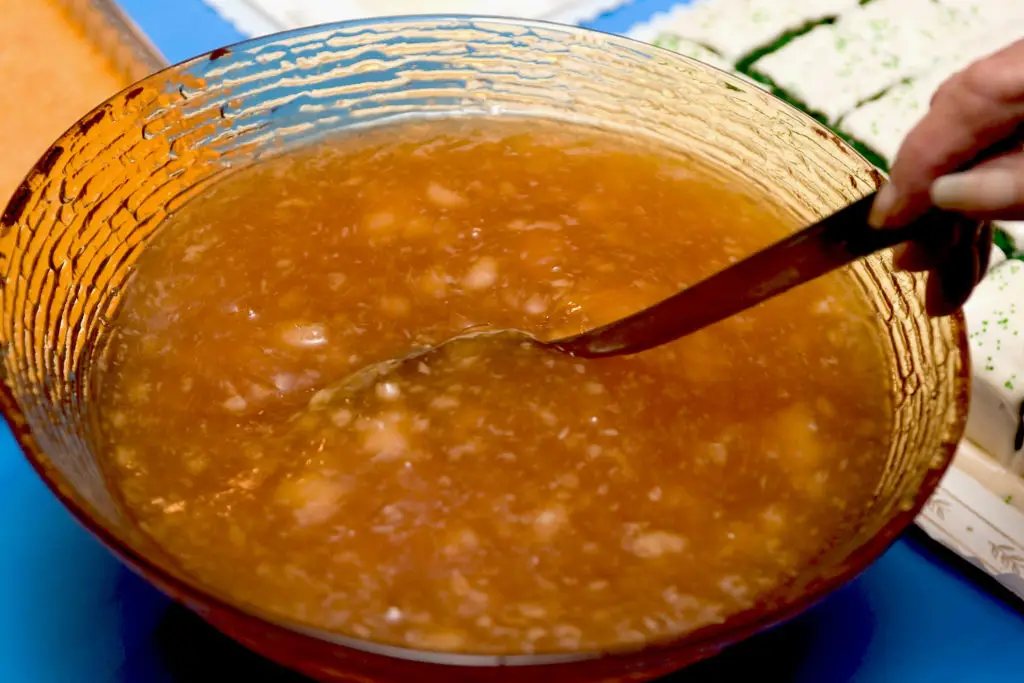Åhu: Sweet Coconut Porridge

Table of Contents
Share This
Description
A sweet, syrupy drink made with young coconut.
History
The concept of thickening a sauce with starch was probably introduced during the Spanish period (17th through 19th centuries) at about the time when corn was also introduced as a supplemental food staple that helped further the development of tortillas (called titiyas) as a starchy addition to meals. Corn kernels, when mashed until powdery and mixed with water created a doughy texture that was then flattened into a circular shape and heated over a flat griddle became the titiyas.
Further, an ample powdery mixture was set aside and left to dry in the hot, open air then stored in earthen jars. It was not stored too long because of insect infestations and the humidity would leave them rotten, but, when mixed with water until thick in consistency thus created the corn starch used for clothes for ironing as well as the ingredient of the early forms of åhu.
The fact that caramelized sugar is a key ingredient also places it into the realm of introduced cooking methods. Tuba syrup (sweet coconut sap cooked down to form molasses) could have been used in place of sugar, but this process has not been described in documents or oral histories. Åhu has been considered a traditional dessert for centuries, and therefore was probably introduced very early in the Spanish colonial period.
Evolution
Åhu (pronounced “ahh-hoo”) seems to be an evolution of an ancient delicacy referred to in missionary documents as “laulau.” (Laulau refers to trembling or shaking in CHamoru, the indigenous people and language of Guam and the Mariana Islands). Both are made of the young coconut which has formed a soft custard-like meat. This stage is called “månha”. Missionary Father Pedro Coomans described the making of laulau from ground rice and young coconut, whereby the månha is pounded with ground rice and formed into little balls, then mixed with the sweet månha juice. The process of making laulau has survived, and this dish is served uncooked as a cool, refreshing drink.
Åhu, however, would be the next logical step from laulau, whereby the starchy rice and juice combination was boiled and thickened. Åhu contains small pieces of månha meat mixed with starch, which becomes chewy during the boiling process.
Åhu today is made from månha mixed with tapioca starch. It is sweetened with sugar that may be caramelized to create a rich, brown liquid; or with uncaramelized sugar which creates a light, gray liquid. Both versions have chewy little gels made by mixing the månha bits with starch.
Preparation
Select månha from bunches of green nuts that are smaller and higher in the tree than the more mature nuts towards the bottom. Test by opening a young coconut to see if the meat is at a soft jelly-like stage. (The shell will also be softer and lighter-colored as opposed to the mature, brown shell). Open the nuts and save the juice and meat separately. Other ingredients include sugar and tapioca starch. Tapioca starch is preferable to cornstarch because it produces a softer, more chewy consistency. Elders have advised that arrowroot starch (gåpgap) can also be used.
Placement on table
Åhu is placed with other desserts, either at the end of the main table or on a separate dessert table. It is usually served in a large bowl, with a ladle to pour a portion into disposable or glass cups arranged next to the bowl.
Recipe
Åhu: Sweet Coconut Porridge
- 2 young coconuts (månha stage)
- 1 cup sugar
- Tapioca starch
- Water
Two månha coconuts will produce about a quart of åhu. To obtain the juice, first cut a small hole towards the top of the nut (with machete or very sharp knife), and drain the juice into a container. Next, cut the nut in half and scrape out the soft meat with a spoon. Save this in a separate bowl and chop or mash the meat into small pieces (a blender may be used). Add tapioca starch to the månha mixture until it forms a glutinous mass. Caramelize one cup of sugar (or more to desired taste) by melting it in a pot large enough to contain the finished åhu (4 – 6 quart pot). When the sugar has turned to a brown liquid, quickly add the månha juice and enough water to make 2 quarts. When the liquid begins to boil, drop in small bits of the månha-starch mixture. For safety from hot splashes and to create a more consistent size of gels, a wire ½ inch mesh screen is recommended to strain the glutinous mass into the boiling liquid. Continue boiling until the liquid has thickened and the bits of månha-starch have turned to gel. If the liquid is too thick, more water may be added. Likewise, if it is too thin, a small amount of water (or cooled liquid) mixed with more starch may be added.
* Recipe provided by Judy Flores, PhD
Video
Watch more Fiesta Table video demonstrations here.
